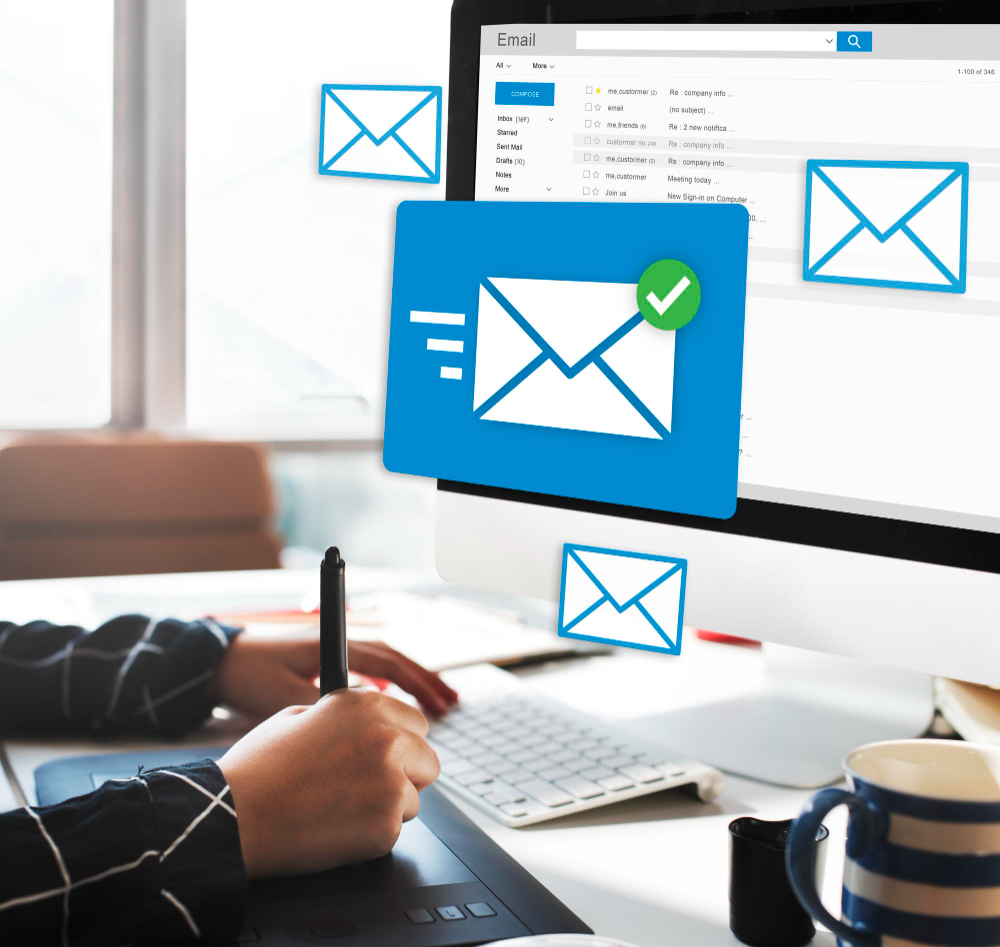Why Email Marketing Still Matters in 2023: A Comprehensive Guide

In the ever-changing landscape of digital marketing, some tactics come and go, but email marketing continues to stand the test of time. Despite the rise of social media, chatbots, and other communication channels, email remains a powerful tool for businesses to connect with their audiences. In this comprehensive guide, we'll explore why email marketing still matters in 2023 and provide tips and best practices to help you succeed.
The Benefits of Email Marketing
One of the main reasons why email marketing continues to be relevant in 2023 is its effectiveness. Email has consistently been shown to have a higher return on investment (ROI) than other digital marketing channels. According to a study by DMA, the average ROI for email marketing is $42 for every $1 spent. That's a significant return, making it a smart investment for any business.
Email marketing also offers a direct line of communication to your audience. Unlike social media or search engine marketing, which rely on algorithms and ad placements, email marketing puts your message directly in your subscriber's inbox. This allows you to create a more personal connection with your audience and build trust with them over time.
Best Practices for Email Marketing
To make the most of your email marketing efforts, it's important to follow best practices. Here are a few tips to help you succeed:
1. Build Your List Organically
Building an email list organically involves attracting subscribers to your list without resorting to paid or forced methods. Here are some tactics you can use to build your list organically:
- Create Valuable Content: Offer content that people find valuable and want to engage with. Your content can be in the form of blog posts, videos, podcasts, or infographics. Ensure your content is well-written, informative, and easy to consume.
- Use Opt-in Forms: Use opt-in forms on your website or blog. Place them in strategic locations such as the sidebar, footer, or within the content. Make the opt-in forms easy to fill out, and provide a clear benefit for subscribing to your list.
- Offer Lead Magnets: Offer a free resource such as an eBook, checklist, or guide in exchange for email addresses. Ensure that the lead magnet is relevant to your audience and of high value.
- Run Contests: Host a contest or giveaway where participants must subscribe to your email list to enter. Ensure that the prize is valuable and relevant to your audience.
- Attend Events: Attend events such as conferences, trade shows, or meetups in your industry. Network with attendees and collect email addresses of interested parties.
- Use Social Media: Promote your email list on your social media channels. Create posts that encourage people to subscribe, and provide a clear benefit for doing so.
- Partner with Others: Collaborate with other businesses or influencers in your industry. Host a joint webinar or create a co-branded piece of content, and exchange email addresses with each other's subscribers.
Remember, the key to building an email list organically is to provide value to your audience and make it easy for them to sign up. By implementing these tactics, you can grow your list and connect with your audience in a meaningful way.
2. Segment Your List
Segmenting your email list allows you to send targeted messages to specific groups of subscribers based on their interests, behavior, or demographics. By dividing your email list into smaller segments, you can create personalized messages that resonate with your subscribers and drive better engagement and conversions.
Here are some ways in which segmenting your email list can help you send targeted messages:
- Interests: You can segment your list based on your subscribers' interests and preferences. For example, if you sell clothing, you could segment your list by men's and women's clothing or by specific styles, such as casual or formal wear. This allows you to send targeted messages that are relevant to each segment.
- Behavior: You can segment your list based on your subscribers' behavior, such as whether they have opened or clicked on previous emails, or whether they have made a purchase. This allows you to send targeted messages that are more likely to be of interest to them.
- Demographics: You can segment your list based on demographics, such as age, gender, location, or job title. This allows you to create messages that are tailored to the specific needs and preferences of each segment.
By sending targeted messages to your email subscribers, you can improve your email open and click-through rates, increase engagement and conversions, and build stronger relationships with your subscribers.
3. Personalize Your Emails
Personalization is the key to building a strong connection with your subscribers because it shows that you understand and care about their individual needs and preferences. By tailoring your messages to each subscriber's interests, behavior, and demographics, you can create a more meaningful and relevant experience for them.
Here are some ways in which personalization can help you build a strong connection with your subscribers:
- Increases relevance: Personalization allows you to send messages that are more relevant to each subscriber's specific interests and needs. When your messages are tailored to their individual preferences, they are more likely to engage with your content and feel that your brand understands and cares about them.
- Builds trust: When subscribers receive personalized messages that are relevant to their needs and preferences, they are more likely to trust your brand and feel that you understand their specific challenges and goals. This can help build a stronger relationship between you and your subscribers, which can lead to increased loyalty and advocacy.
- Improves engagement: Personalized messages are more likely to be opened, read, and acted upon by your subscribers, which can lead to increased engagement and conversions. When subscribers feel that your messages are tailored to their interests and needs, they are more likely to take action on your calls-to-action and engage with your brand on a deeper level.
Personalization is the key to building a strong connection with your subscribers because it allows you to send messages that are more relevant, build trust, and improve engagement. By leveraging personalization in your email marketing strategy, you can create a more meaningful and valuable experience for your subscribers, which can lead to long-term relationships and business success.
4. Test and Optimize
It is important to test different tactics, subject lines, and messaging to see what resonates with your audience because it allows you to optimize your email marketing strategy and improve your engagement and conversion rates.
Here are some reasons why testing is important:
- Helps you understand your audience: By testing different tactics and messaging, you can gain insights into what resonates with your audience and what does not. This can help you better understand their preferences and behavior, which can inform your future email marketing campaigns.
- Improves engagement rates: When you test different subject lines, messaging, and calls-to-action, you can identify the strategies that are most effective at engaging your audience. This can lead to higher open and click-through rates, which can help drive more traffic and sales for your business.
- Increases conversion rates: By testing different messaging and calls-to-action, you can identify the tactics that are most effective at converting subscribers into customers. This can lead to higher conversion rates and increased revenue for your business.
- Helps you stay competitive: By constantly testing and optimizing your email marketing strategy, you can stay ahead of the competition and continue to improve your results over time.
Testing different tactics, subject lines, and messaging is important because it helps you better understand your audience, improve your engagement and conversion rates, and stay competitive in your industry. By leveraging data and insights from testing, you can optimize your email marketing strategy and drive better results for your business.
Tips for Email Marketing Success
Beyond best practices, there are a few additional tips to help you succeed with email marketing in 2023:
1. Mobile-Optimize Your Emails
Using responsive design is a great way to ensure your emails look great on any device, and keeping your messaging short and to the point can further enhance the effectiveness of your emails. Here are some tips on how to accomplish both:
- Use a responsive email template: A responsive email template automatically adjusts to the screen size of the device on which it is viewed. This ensures that your emails look great on desktops, laptops, tablets, and smartphones. Use a template that is specifically designed for email marketing, and that has been tested for responsiveness across a variety of devices and email clients.
- Keep your message short and to the point: Most people have a short attention span when it comes to reading emails, so it's important to keep your message brief and to the point. Use a clear subject line that accurately reflects the content of your email, and avoid using jargon or overly technical language. Use bullet points or numbered lists to break up text and make it easier to read.
- Use images wisely: Images can enhance the visual appeal of your emails, but they can also slow down load times and make your email look cluttered. Use images sparingly and make sure they are optimized for the web so they load quickly. Use alt text for images in case they don't load or are blocked by email clients.
- Use a single-column layout: A single-column layout is easier to read on small screens than a multi-column layout. It also makes your email look cleaner and more professional. Use a font size that is easy to read, such as 14-16 pixels for body text.
- Test your emails: Before sending your emails, test them across different devices and email clients to ensure they look great and are easy to read on any device. Make sure your call-to-action buttons are easy to tap on mobile devices and that all links work correctly.
Using responsive design and keeping your messaging short and to the point are both important for creating effective email campaigns. By following these tips, you can create emails that are visually appealing, easy to read, and optimized for different devices, which can help drive better engagement and conversions.
2. Use Automation
Automation can help you send triggered messages based on subscriber behavior, welcome new subscribers, and re-engage inactive subscribers. Here's how:
- Triggered messages based on subscriber behavior: Use automation to send messages triggered by specific subscriber actions, such as making a purchase, abandoning a shopping cart, or clicking on a particular link. For example, if a subscriber abandons their shopping cart, you can send them an automated email with a special offer to encourage them to complete their purchase.
- Welcome new subscribers: Use automation to send a series of welcome messages to new subscribers to introduce them to your brand, products, and services. You can use these messages to set expectations, provide helpful information, and invite subscribers to engage with your brand on social media or through your website.
- Re-engage inactive subscribers: Use automation to send targeted messages to subscribers who have not engaged with your emails in a while. For example, you can send a special offer or exclusive content to entice them to open and engage with your emails again.
To set up these automated messages, you'll need to use an email marketing platform that supports automation. Here are the general steps to follow:
- Set up triggers: Identify the specific subscriber behaviors that will trigger your automated messages, such as making a purchase or clicking on a link.
- Create message content: Develop the content for your automated messages, including the subject line, body text, and any images or links.
- Set up your automation workflow: Use your email marketing platform to set up your automation workflow, including the triggers, message content, and timing.
- Test and refine: Test your automated messages to make sure they are working as intended, and refine them over time based on subscriber engagement and feedback.
Automation can help you send targeted messages to your subscribers based on their behavior, welcome new subscribers, and re-engage inactive subscribers. By using automation to streamline your email marketing efforts, you can save time and resources while delivering more personalized and effective email campaigns.
3. Integrate with Other Channels
Integrating your email marketing efforts with other channels, such as social media or your website, can help you create a seamless experience for your subscribers and maximize the impact of your marketing campaigns. Here are some tips for integrating your email marketing with other channels:
- Include social media links in your emails: Include links to your social media profiles in your email messages, and encourage subscribers to follow you on social media for more updates and engagement opportunities. You can also include social sharing buttons in your emails to make it easy for subscribers to share your content with their own networks.
- Promote your email list on social media: Use your social media channels to promote your email list and encourage followers to sign up. You can also use social media ads to target specific audiences and drive more sign-ups.
- Use email to drive traffic to your website: Include links to your website in your email messages, and use calls-to-action to encourage subscribers to visit specific pages or take specific actions on your site. You can also use email campaigns to promote special offers or events on your website.
- Use website data to inform email campaigns: Use data from your website, such as visitor behavior and conversion rates, to inform your email marketing campaigns. For example, if you notice that a particular product or page on your website is popular, you can use that information to create targeted email campaigns around those topics.
- Use marketing automation to connect channels: Use marketing automation tools to connect your email marketing efforts with other channels. For example, you can set up an automation workflow that triggers an email message when a subscriber engages with your brand on social media or takes a specific action on your website.
By integrating your email marketing efforts with other channels, you can create a more cohesive and effective marketing strategy that engages your subscribers across multiple touchpoints. By following these tips, you can create a seamless experience for your subscribers and drive better engagement, conversions, and customer loyalty.
Email marketing continues to be a critical component of any digital marketing strategy due to its high ROI and wide reach. Email marketing campaigns have a high return on investment, with an average ROI of $42 for every $1 spent. Email is also a universal communication channel, used by billions of people around the world for personal and professional purposes. Additionally, email marketing allows for personalized and targeted messaging, making it an effective way to reach and engage with specific segments of a target audience. Integrating email marketing with other digital marketing channels, such as social media and website, can also create a more cohesive and effective marketing strategy. Overall, email marketing remains a valuable tool for businesses to reach and connect with their customers.
--------------------------------------
ZapMyWork.com is your one-stop shop for all your freelance needs. We are an online marketplace that connects clients with skilled and talented freelancers from around the world. One of the things that sets us apart from other freelance marketplaces is our rigorous screening process. We carefully vet all of our freelancers to ensure that they have the skills and experience to deliver high-quality work, one project at a time. Let us know how we can help you today!
Recent Posts
-
04/26/2024Thriving Through Flexibility: How FlexiConsulting Found Success with ZapMyWork
-
04/19/2024Flourishing Home Trends: How "ZapMyWork" Became the Cornerstone of Our Interior Design Success
-
04/15/2024Weaving Success with ZapMyWork's Freelance Marketplace
-
04/12/2024Streamlining Project Management in Small Businesses: The ZapMyWork Experience with ClearVision Consulting
-
04/10/2024Transforming Toy Design with Electronics Engineering Freelancers: A Case Study on ToyInnovate
Store Address
Information
Copyright © 2022 - Present. ZapMyWork, LLC. All Rights Reserved




